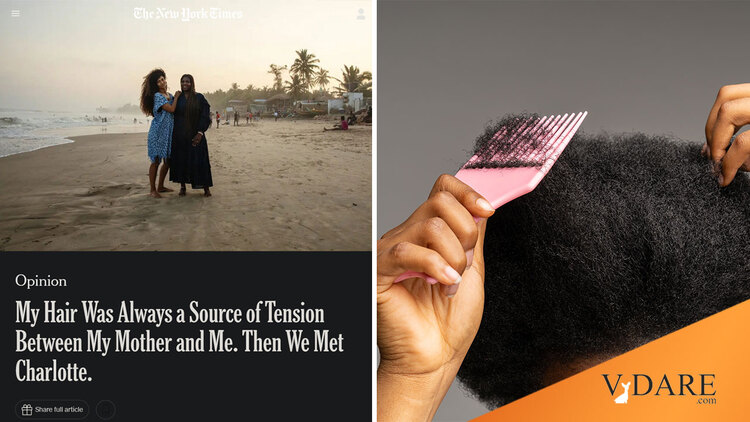
Steve Sailer: “The NEW YORK TIMES Published My Parody Of The Ultimate World War Hair Article!“
By Steve Sailer
10/07/2023
See earlier World War Hair coverage from Steve Sailer.
From The New York Times opinion page:
Opinion
My Hair Was Always a Source of Tension Between My Mother and Me. Then We Met Charlotte.
Photographs and Text by Malin Fezehai
I see a movie in this great story
My Hair Was Always a Source of Tension Between My Mother and Me. Then We Met Charlotte. https://t.co/hdydQNP3Tk
— Nneka Samuel (@NeekNique) October 7, 2023Ms. Fezehai is a Swedish Eritrean photographer and visual reporter based in Nairobi, Kenya.
Oct. 6, 2023
As a child of mixed-race heritage, I often found that my hair was a source of tension between my mother and me. My father hails from Eritrea in East Africa, and my mother is from Sweden, so she and I have vastly different hair textures. When I was a girl — until about the age of 10 — my thick and curly hair was a nightmare for her to manage.
In the early 1990s, Sweden that had yet to acknowledge just how multicultural its society had become. At times, people could be cruel. My schoolmates would stick pencils in my hair to see how many it would hold. I resented going to Swedish hair salons because I could see hairdressers’ expressions grow annoyed as soon as I walked in the door. At these salons, they tried to thin my hair to make it more “normal,” resulting in a series of awkward haircuts. You will never see the photos to prove it. I longed to fit in; all I wanted was straight hair.
Despite our sometimes turbulent relationship, my mother recognized that I was struggling socially, and she came up with a plan. In December 1996 she booked tickets to London to get my hair straightened. This was no small feat for a single mother of five who owned a small cleaning company, but she found child care, and the two of us stayed at a cheap hotel where the heater didn’t work. I still recall sitting in the lobby at 5 a.m., half dazed, as my mother complained about our freezing room to the receptionist, who, assuming we were Jewish, began berating us with antisemitic slurs.
While today practically every street food vendor and back-alley barbershop can be found on social media, in 1996 we had to walk the streets of London hoping that fate would bring us to the right kind of hair salon. London, to me, was a patchwork of communities, vibrant and exciting for a girl coming from Stockholm. We walked into one salon that had pictures of Black women on the wall, all with different hairstyles. The hairdressers and clients looked at me the way I imagined they’d smile at a lost kitten. We booked an appointment for the next day.
When we returned, the entire place was crisscrossed with caution tape and police cars. There had been a murder in the salon. My mother panicked briefly, stopped an officer and, in her accented English, said, “You see, my daughter, she had an appointment, and we are going back to Sweden tomorrow.” The police officer stared, and I pulled my mother away. …
